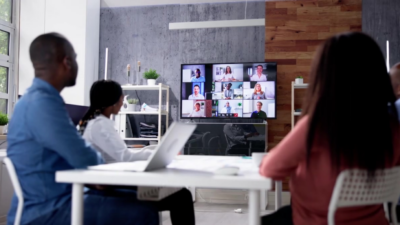“Do you want to just go to the bar?” And so ends the meeting that two creatives with a well-known ad firm were attempting to hold in the outdoor collaboration space at their downtown office building.
It turns out that when the temperature hits 90 degrees with 80% humidity in Minneapolis, a downtown parking ramp with an artificial turf rug and the smell of car exhaust doesn’t create the live-work-play-third-workplace the owner of this particular building was aiming for.
This example is a good reminder that the effective use of surrounding outdoor environments can be a major reason why one office building thrives while another flounders. In my work, I focus on the suburban office market and I have seen that in particular, incorporating natural elements in the workplace is one way that suburban building owners can compete with the reality of urban migration.
Naturally Inclined
Connecting a workplace to the outdoor environment is not a trend; it satisfies a base yearning that workers have felt since the first caveman exchanged a dozen clubs for a wooly mammoth pelt.
But today, employers are demanding more of their increasingly millennial-driven workforces than ever before. In May of this year, The Washington Post reported that the average work week is now up to 47 hours per week — almost a full extra workday.
With the increased workload, savvy corporate leaders are offering flexibility and amenities in order to attract and retain talent — and smart landlords are paying attention. An easy escape during the workday to a comfortable outdoor environment on-campus can allow employees time to recharge or collaborate in a relaxed setting while getting fresh air. This can not only aid a healthy and happy corporate culture but also increase productivity, which is a win for executive decision-makers.
The Nature Advantage
One building owner I work with, Piedmont Office Realty Trust, owns Crescent Ridge II — a 300,000-square-foot Class A office property that enjoys the competitive advantage of an adjacent nature preserve. The running, walking and biking trails in the preserve are a treasured amenity for tenants who are able to enjoy a quick outdoor workout or a water view from their office.
Seth Redfield, property manager for Piedmont, summarizes the relationship with the preserve: “This past year we made a significant investment in our cafeteria and the upgrade was favorably received by tenants. As the weather turned sunny these past few weeks, it’s been remarkable how many tenants have gravitated toward the cafeteria’s outdoor patio overlooking the preserve. We’re in the process of examining how to better leverage our natural surroundings: whether it be with another augmented patio area off our lobby for informal gatherings and tenant socials or better connectivity to the nature trail for the runners and bikers.”
Nature’s Effect
In addition to providing a needed escape during a busy workweek, an outdoor space can provide the necessary “hip and progressive” factor to differentiate a building from its competition. For example, a building owner I work with, Felton Properties, was faced with significant vacancy in the stagnant sub-market of suburban Edina, MN. To combat this, Felton Properties updated an underutilized courtyard space at its Braemar Office Park property.
The renovation added a new outdoor patio, fire pit, lawn games area and a putting green. Following the renovation, the property attracted 40,000 square feet of new leases in 2016 — in a market with more than 200,000 square feet of negative absorption that year, according to Colliers research.
Jeff Borlaug, managing director at Felton Properties, says of the updated courtyard: “We really wanted to activate that outdoor area by bringing in people to collaborate or relax in the space. As an owner, we know you have to create that live-work-play experience in the suburbs so that tenants and their employees want to be there. It’s all about the tenant experience and providing that opportunity to jump away from the desk at 4:00, grab a shot of espresso at the café, putt around the green or play a game of corn hole. An executive may never use that putting green but if they can tell a recruit that ‘we have a putting green at our office,’ that can be a differentiating amenity that stands out with a potential employee.”
Connecting to outdoor space in a manner that will provide a meaningful amenity for office tenants does not come without a cost to building ownership. That said, when done well, it can provide the differentiating factor needed to attract tenants and a return on investment equal to, or better than, interior renovations.
Prioritizing Connectivity
The prioritization of resources allocated to outdoor space as part of commercial development is as age-old an issue as a worker’s desire for connectivity to nature. For inspiration, we can turn to famed naturalist John Muir, who stated:
“The making of far-famed New York Central Park was opposed by even good men, with misguided pluck, perseverance and ingenuity, but straight right won its way, and now that park is appreciated. So we confidently believe it will be with our great national parks and forest reservations.”
Even the most conservative of New York commercial developers would be challenged to minimize the positive impact on real estate, the city’s economy and the New York worker’s sustained well-being that the establishment of those 778 acres of park space — in lieu of development — has produced over the past 160 years.
With the demand for increased productivity and performance resulting in a longer work week, the habitat of the modern worker can easily be defined as the built environment. Spending upwards of 90% of our time within the confined walls of office buildings, we often have no outlet for our innate need for connections to nature, which is essential to our health and well-being.
Today’s office owners would be well-served to heed the words of Mr. Muir and strategically devote resources to improving their property’s connectivity to nature.

 Colliers Insights Team
Colliers Insights Team
 Anthony Shell
Anthony Shell
 Andrew Steele
Andrew Steele
 Aaron Jodka
Aaron Jodka Michelle Cleverdon
Michelle Cleverdon